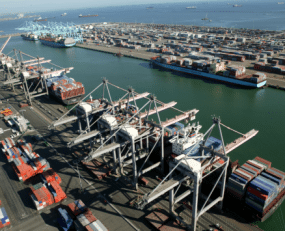
January is typically an interesting time for ports on the US West Coast but reports of congestion at LA/Long Beach highlight a number of frailties in US inbound supply chains.
The reason for the usual rush at this time is Chinese New Year. Although ports are only closed for a few days, the holiday period sees Chinese manufacturing shutdown for up to a few weeks. US importers therefore have to secure space on ships well in advance to avoid disruption.
However, this time around, congestion at ports appears to be particularly bad. Port of Long Beach Executive Director Mario Cordero has stated: “We’re seeing unprecedented levels of cargo at the Port of Long Beach. Marine terminal operators, the International Longshore and Warehouse Union, shipping lines, truckers and other stakeholders are working hard to manage resources.”
Similar issues are being reported at neighbouring Los Angeles. Between them, they handle around one third of US inbound containers.
The main problem is that in addition to Chinese New Year, tariffs (or perhaps more accurately the threats of tariffs) are playing a large part. On December 1, the US and China called a truce on new tariffs which would have hit $200bn of Chinese products. However, even before this extension was agreed, importers were planning ahead, piling up inventory in anticipation for their implementation on January 1. This in effect means stock-piling has been taking place for a number of months now. Going back further in the year, prior tariffs have also caused similar issues.
The major US West Coast ports have had a strong year. In 2018, both Los Angeles and Long Beach posted record years for TEU throughput. Long Beach handled 8.091m TEUs, up 7.2%. Los Angeles handled 9.459m TEUs up 1.2%, helped by a record December, in which TEUs grew 15.9% year-over-year. The strength of the US economy has been a key driver of this.
Throughput at Los Angeles and Long Beach
Although volumes are seemingly good, logistics costs are becoming particularly painful for shippers. The swelling financial costs of holding excess inventory are concerning, especially given talks of a slowdown in the US economy. At times of a downturn, holding high inventory can be an existential threat to a business. Warehousing costs are running at a premium as e-commerce players battle for available space. In addition, driver shortages are hurting US supply chains. Latest figures from The American Trucking Association (ATA) showed that in 2017, US trucking was 50,000 drivers short. Truck driver shortages dominated freight headlines in the US (and Europe) in 2018 and we’re starting to see the results of this in higher freight rates.
Given the scale of existing issues, port congestion is a headache that US importers could do without!
Source: Transport Intelligence, January 29, 2018
Author: Andy Ralls
For further data on port volumes, freight rates, inventory-to-sales ratios, and over 100 additional data sets, click here.